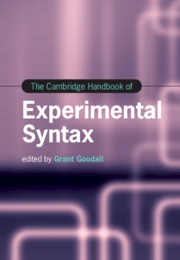Book contents
- The Cambridge Handbook of Experimental Syntax
- The Cambridge Handbook of Experimental Syntax
- Copyright page
- Contents
- Figures
- Tables
- Contributors
- Introduction
- Part I General Issues in Acceptability Experiments
- 1 Sentence Acceptability Experiments: What, How, and Why
- 2 Response Methods in Acceptability Experiments
- 3 Approaching Gradience in Acceptability with the Tools of Signal Detection Theory
- 4 Variation in Participants and Stimuli in Acceptability Experiments
- 5 Acceptability, Grammar, and Processing
- 6 Satiation
- 7 Acceptability (and Other) Experiments for Studying Comparative Syntax
- Part II Experimental Studies of Specific Phenomena
- Part III Experimental Studies of Specific Populations and Language Families
- Part IV Experimental Syntax beyond Acceptability
- Index
- References
2 - Response Methods in Acceptability Experiments
from Part I - General Issues in Acceptability Experiments
Published online by Cambridge University Press: 16 December 2021
- The Cambridge Handbook of Experimental Syntax
- The Cambridge Handbook of Experimental Syntax
- Copyright page
- Contents
- Figures
- Tables
- Contributors
- Introduction
- Part I General Issues in Acceptability Experiments
- 1 Sentence Acceptability Experiments: What, How, and Why
- 2 Response Methods in Acceptability Experiments
- 3 Approaching Gradience in Acceptability with the Tools of Signal Detection Theory
- 4 Variation in Participants and Stimuli in Acceptability Experiments
- 5 Acceptability, Grammar, and Processing
- 6 Satiation
- 7 Acceptability (and Other) Experiments for Studying Comparative Syntax
- Part II Experimental Studies of Specific Phenomena
- Part III Experimental Studies of Specific Populations and Language Families
- Part IV Experimental Syntax beyond Acceptability
- Index
- References
Summary
This chapter attempts to give an overview of current methods of gathering controlled acceptability judgments, noting what parameters of variation there are.Issues dealt with include the ways that the stimulus can be presented, the task assigned to the informant, the criterion for acceptability which the informant is instructed to use, and the format in which the response is delivered.A particular focus is the issue of the scale type on which the judgments are given.The chapter argues for more sophisticated (and admittedly) complex scales, and presents the case for anchoring the scale points with lingustic examples in order to ground the scale intersubjectively. These anchor points can be provided by the use of standard items instantiating cardinal well-formedness values, such as those proposed in Gerbrich et al. (2019).
Keywords
- Type
- Chapter
- Information
- The Cambridge Handbook of Experimental Syntax , pp. 39 - 61Publisher: Cambridge University PressPrint publication year: 2021
References
- 3
- Cited by



